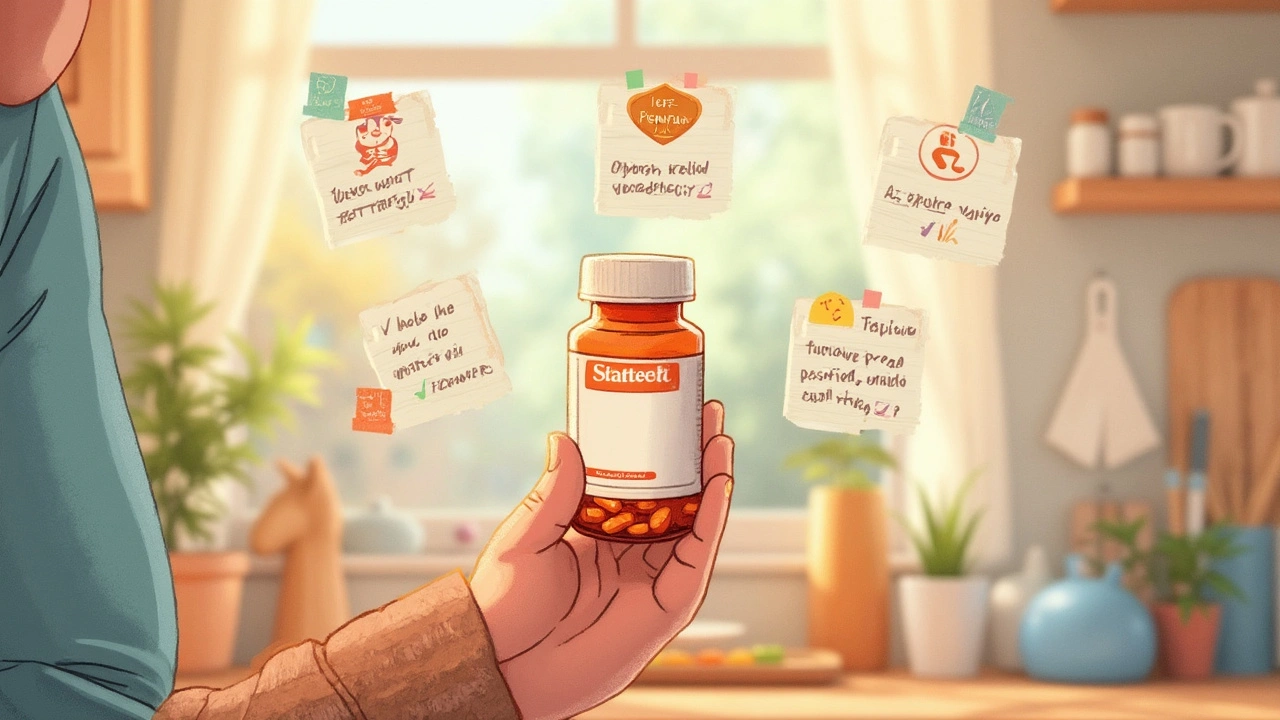If you search for alternatives to the usual ADHD medications, one name keeps popping up: Strattera. It’s a bit of an outlier in the ADHD world—a non-stimulant, officially called atomoxetine. Unlike Ritalin or Adderall, Strattera won’t have you feeling wired, and for some folks, that’s perfect. Here in Australia, people are asking their GPs about it more than ever, hoping for something that fits into real life without the baggage of other drugs. So, what makes Strattera stand apart, why might you swap it for your usual meds, and what can you actually expect?
How Strattera Works Differently from Stimulants
Most people know stimulants like methylphenidate (the active stuff in Ritalin) or dexamphetamine. These are the old guard of ADHD treatment, jacking up dopamine and norepinephrine quickly. Atomoxetine, the active ingredient in strattera, is nothing like that. Instead of giving you a quick buzz, it slowly increases norepinephrine levels over days and weeks. The result: a much gentler effect on your focus and mood. For people sensitive to the jittery side of stimulants or those with a history of addiction, this gradual approach can be a game changer.
The science isn’t just hearsay. According to evidence published in the Journal of the American Academy of Child & Adolescent Psychiatry, Strattera can improve attention and reduce impulsivity—in both kids and adults—with proven results kicking in after a few weeks. It won’t spike your energy or crash you later, but instead, you may notice you start finishing tasks, keeping track of time, or feeling less scattered.
What also stands out: atomoxetine is not a controlled substance in Australia. That means you don’t get the same red tape around scripts, travel is easier, and doctors can prescribe it even if you have a history where stimulants are discouraged. This opens the door for heaps more people to access ADHD treatment.
And while the onset is slower (most people notice changes after two to four weeks), for those who stick with it, Strattera can become part of a smoother, more stable daily routine. There’s no roller-coaster of highs and lows—just a steady background help, like someone quietly nudging you back on track every now and then. That predictability is a big win if your life is already filled with enough surprises.
Benefits and Real-World Effects of Strattera
The true test of any ADHD medication isn’t just in a lab—it’s whether it gets you through the school run, that massive spreadsheet, or keeping up with conversations during Friday drinks. Here’s where Strattera starts to shine for the right people.
People who respond to Strattera often talk about newfound focus that just feels normal, not forced. Many say it’s easier to organize their thoughts, start things they kept putting off, and tone down the impulsivity that’s made life tricky. For parents, that might mean the difference between a homework battle and a kid who can actually sit through their assignments without tears (from either side).
Adults tell similar stories. One Perth tradie shared how Strattera helped him stop forgetting gear and tools at sites and finish quotes on time. A university student I met described how her marked-up lecture notes and “mental white noise” finally quieted down, so she actually remembered what she’d read. Unlike with stimulants, there’s very little chance of insomnia or anxiety spikes, so sleep doesn’t take a hit for most people—and some even find they sleep better because their mind slows down at night.
It’s not for everyone, though. If you need a quick fix for hyperactivity or severe inattention, waiting weeks for Strattera’s effects can be frustrating. And it won’t magically boost your mood—though, according to a 2023 review published in The Lancet Psychiatry, some people report less emotional volatility and less ‘reactivity’ throughout the day. That can mean fewer big blowups or meltdowns, something families really appreciate.
Here’s a nifty comparison so you can see how Strattera lines up against the classics:
| Feature | Strattera (Atomoxetine) | Stimulants (e.g. Ritalin, Adderall) |
|---|---|---|
| Controlled substance? | No | Yes |
| Speed of onset | 2-6 weeks | 30-60 minutes |
| Abuse potential | Low | High |
| Sleep impact | Minimal | Often causes insomnia |
| Common side effects | Dry mouth, appetite loss, nausea | Appetite loss, jitteriness, heart rate increase |
Treatment is personal, but it’s easy to see why Strattera is gaining traction for those who want less fuss, less risk, and a more ordinary-feeling improvement.

Side Effects, Safety, and Myths about Strattera
Whenever I chat to people about ADHD meds, the same worries pop up: “Will it change who I am?” or “What if it messes with my heart?” Strattera gets its fair share of myths, so let’s bust those open and look at what doctors and people actually see on the ground.
Here’s the reality—Strattera’s side effects are usually mild. The most common are dry mouth, less appetite, nausea, and for some, a sleepy or tired feeling, especially when starting. Most of these chill out within a few weeks. One tip from people who've been on Strattera: have snacks ready, especially if you’re feeling queasy in the morning.
Heart safety is another big talking point. Unlike stimulants, Strattera hardly pushes up your blood pressure or heart rate. Sure, data from an Australian post-market study published in 2022 did show tiny bumps in heart rate (about three to five beats per minute), but these almost never cause problems. If you already have a pre-existing heart condition, your doctor will want an ECG before you start—standard stuff.
People also worry about mood swings or emotional “flatness.” There’s a grain of truth here, as some folks report feeling a bit emotionally blunt for the first month. Adults sometimes describe feeling less passionate or less easily excited. But usually, this fades after your body reaches steady levels of the medication.
Anxiety can be a curveball. Some people do get more anxious, especially at the start, but more typically, it’s the opposite. If you’re someone who’s socially anxious or overthinks everything, the lower impulsivity can help you pause before blurting out things you regret. Still, if you’re feeling constantly on edge or having trouble functioning, speak up to your doctor—sometimes it just means the dose needs a tweak.
Then there are rarer, but serious, risks—liver injury, severe allergic reactions, and suicidal thoughts (mainly in kids and teens). The numbers are low. According to the FDA, about 1 in 1,000 children may notice suicidal thinking, especially in the first few months. That’s why doctors keep close tabs early on, and why it's always worth telling someone if something feels off.
If you love your beer or wine, know this: Strattera and alcohol don’t really mix, not because of a direct reaction, but because both can make you feel off your game. Some doctors recommend cutting down at first until you know how the medication affects you day to day.
Here are a few practical tips from people who’ve gone through the first months with Strattera:
- Taper up slowly, especially if you’re prone to nausea or are super sensitive to meds.
- Take it at the same time daily, usually in the morning.
- If you get drowsy, try splitting the tablets—half in the morning, half later in the day (ask your doctor first).
- Stay hydrated to avoid dry mouth and headaches.
- Check in with your doc every few weeks during the first three months.
Myth: “If Strattera doesn’t work, nothing will.” Not true. If this drug isn't your match, there’s a whole toolbox of ADHD options—meds, therapy, lifestyle hacks—that can still help massively. The med world isn’t black-and-white.
Who Should (and Shouldn’t) Try Strattera — Plus, Aussie-Specific Tips
Here’s a quick reality check: Strattera isn’t the magic pill for everyone with ADHD. But if you’re a right fit, it can really change the game.
This med is most often recommended to:
- People (adults or kids) who react badly to stimulants—think awful insomnia, anxiety, or paranoia.
- Folks with substance use history, for whom stimulants are a no-go.
- Parents or patients who want to avoid the “controlled drug” label and all the paperwork that comes with it in Australia.
- Kids with a family history of tics or certain heart issues.
- People who want all-day coverage, not a short burst of focus.
If you have serious liver disease or narrow-angle glaucoma, Strattera is off the table. And for those already taking certain antidepressants (like paroxetine or fluoxetine), big interactions can happen. Always give your pharmacist the full list of meds and supplements you’re on.
In Australia, Strattera is included in the PBS (Pharmaceutical Benefits Scheme) for people diagnosed with ADHD, so if you fit the criteria, you likely won’t pay full price. Still, the approval steps can be a slog. Get ready for specialist assessments, forms, and probably a bit of waiting if you’re going through public clinics in Perth or anywhere else. That said, once you get a script, the fact that you don’t have to store it in a lockbox or deal with pharmacy legalities is a real relief for many families.
Switching from a stimulant to Strattera? Expect a period of overlap (usually a few days to a week) as your body adjusts. You might feel weird, moody, or tired during this “crossover.” For most, that passes by week two. Don’t tough it out alone—every adjustment phase is easier if you talk straight with your doctor and people who get it.
And if you’re supporting someone on Strattera, patience matters. Routine helps. Reminders on your phone, snack packs for nausea, and regular check-ins make the journey way less stressful. Plenty of Perth ADHD support groups on Facebook and other social media have parents and patients swapping stories and hacks—worth checking in for true-life tips locals swear by.
The world of ADHD meds in Australia is changing, with Strattera leading the new wave of options. It’s not about finding the single right answer, but building a toolkit that fits your actual day-to-day life. Whether Strattera is your go-to or just another stop on your journey, knowing what to expect—and how to make it work for you—gives you an edge.


Author
Mike Clayton
As a pharmaceutical expert, I am passionate about researching and developing new medications to improve people's lives. With my extensive knowledge in the field, I enjoy writing articles and sharing insights on various diseases and their treatments. My goal is to educate the public on the importance of understanding the medications they take and how they can contribute to their overall well-being. I am constantly striving to stay up-to-date with the latest advancements in pharmaceuticals and share that knowledge with others. Through my writing, I hope to bridge the gap between science and the general public, making complex topics more accessible and easy to understand.